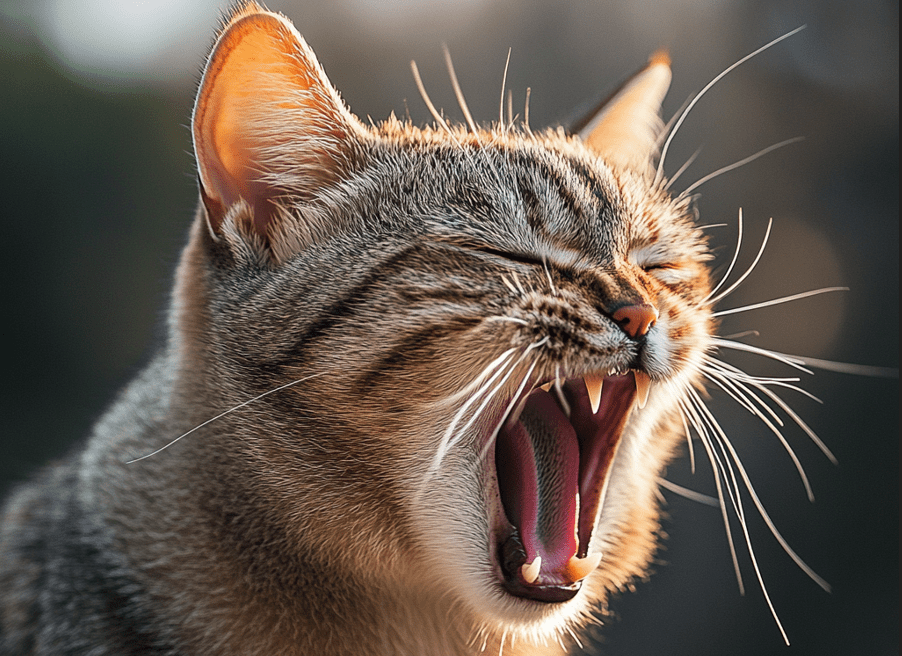
If your cat exhibits more unpredictable behavior instead of showing friendliness, then you might be dealing with fear aggression in cats. It’s a common behavioral issue rooted in their survival instincts. Our homebred pets do not experience threats from wilderness anymore, but their basic responses to perceived danger stay with them. Knowing fear-aggression dynamics in cats proves fundamental to protecting their safety and the safety of your cat. This article explores the causes, signs, and effective strategies to manage fear aggression in cats. Learn how to construct an environment that promotes calmness through trigger identification as well as counterconditioning practice, which will help your valued pet feel more at ease. In this article, we will explain when it becomes crucial to consult a veterinarian or behavior specialist for professional assistance.
What is fearful aggression in cats?
House cats, which humans have raised for thousands of years, still demonstrate many of their original wild feline characteristics. The instinct of wild cats drives them to hunt birds along with mice and reptiles. Their tiny size creates significant exposure to predatory attacks done by coyotes and both eagles and owls. As a result, cats develop an instinctive fighting reaction when they sense potential threats.
Cats perform aggressive actions when they use threatening postures to display dominance or show force against human and animal beings to defend themselves. Even though indoor cats today are free from many of their ancestors’ life-threatening risks, they occasionally display aggressive behaviors toward household people and animals because of fear.
Knowing how your cat displays fear aggression is essential to safeguarding your safety and ensuring your cat remains calm and relaxed. Recognizing the signs a cat is scared can help you address aggressive behavior before it escalates.
Aggressive behavior most frequently emerges in cats because of fear aggression. If you’re wondering how to know if a cat is scared, observing changes in behavior such as hiding, growling, or hissing can provide clues. Your cat shows violent actions because it encounters unfamiliar environmental stimuli, which might be perceived as threatening, whether through new creatures in its territory or unexpected loud sounds.
Cats learn to display fear aggression after experiencing stressful situations in particular areas, which leads to negative associations regarding those locations. The experience of physical restraint during their appointment at a grooming facility might lead to the development of such aggressive behavior in cats. To spot scared cat signs, look for behaviors like crouching, wide eyes, or attempting to escape the situation.
Causes of Fear Aggression in Cats

Fear aggression in cats can have various causes. Common stimuli for fear aggression in cats include:
Feline aggression primarily manifests as fear aggression. Some cats possess the shy gene, which triggers aggressive behavior when they experience fear. When socialization goes poorly, cats will develop fear aggression as a result. Owner-administered punishments can exacerbate the problem. The development of fear in cats leads to aggressive reactions toward unfamiliar individuals or settings and other animals as well as novel sounds and odors. The fearful experience of a vet car trip will trigger similar fearful responses during every subsequent car journey. A solitary unfavorable encounter between cats who have been friends for a long time can produce ongoing hostility between them.
How to Deal with Fear Aggression in Cats
There are a few ways pet parents can address fear aggression in cats. Every method for tackling aggression requires pet parents to maintain two foundational principles:

Counterconditioning serves as an effective tactic to eliminate fear aggression from animals. Qigong techniques aim to make an aggressive cat less sensitive to their perceived threats by building their tolerance steadily during multiple weeks up to months.
To expose the cat to nonaggressive behavior reinforcement, the vacuum should start further away than initially triggering aggressive behavior at a distance of 20 feet (ca. 6 m).
A process of incremental vacuum proximity is performed while the cat receives high-value treats for appropriate behaviors until the cat gets no reaction from the former threatening stimulus.
The pureed meat treat named Churu serves as an excellent reward choice because you can give small tube amounts to cats at a controlled pace equal to less than ten calories per tube. During counterconditioning sessions, an owner must avoid responding to unwanted aggressive behaviors in their cat because the method helps teach the animal that rewards come only from preferred non-aggressive behaviors.
Prevention of Fear Aggression
Some instances exist in which fear aggression prevention becomes feasible but requires additional research. The management of triggering circumstances becomes useful when a cat displays fear aggression toward unfamiliar individuals; thus, visitors should maintain physical space.
Efforts to recognize when cats display fear signs will enhance the speed and effectiveness of counterconditioning procedures since fear-based aggressive behaviors tend to intensify with time. When a cat positions itself in unexpected places during stressful encounters, it reveals fear that could rapidly turn into aggressive behavior without intervention.
Once you discover the exact trigger, your ability to calm down the cat reflects in your progress toward treating its fear aggression. Mild cases of fear aggression in cats may respond well when owners either eliminate the triggers of aggressive behavior or stay away from those causes. Fear reduction methods will be necessary since you cannot either eliminate or identify the triggers causing the fear.
Additional Strategies to Manage Fear Aggression
A mix of different strategies works well as an approach to treat fear aggression, according to some pet owners. Serious fear aggression requires the use of prescription medications, which include fluoxetine and lorazepam. The interventions will help control fear and anxiety until desensitization training begins.
The period of treatment makes cats exposed because they work to erase their learned defensive behaviors. Active punishment does not belong in any aggressive behavior correction method and includes water bottle sprays to prevent animal aggression. The use of shouts proves dangerous and harmful for cats. Punishing a fearful cat increases its fear response. Avoid responding with fear or fleeing when dealing with a biting, aggressive cat that swipes and lunges, as it reinforces the cat’s aggressive behavior. When you offer comfort to an aggressive cat, the animal receives the message that its aggressive behavior has been accepted.
Professional help for cats with fear aggression exists through various strategies that aid in transforming this intense behavioral condition. Developing a suitable plan for the cat requires the advice of its main veterinarian. We may recommend consulting board-certified veterinary behaviorists, professionals from the International Association of Animal Behavior Consultants, or certified IAABC practitioners for further assistance. The most effective approach to treating fear aggression occurs by assessing individual cat needs.
The Role of Veterinarians and Behavior Specialists
The management of fear aggression in cats becomes difficult because multiple treatment options exist. The primary veterinarian needs to check with the cat owner for the best approach to help the pet. The primary veterinarian may recommend consulting a board-certified veterinary behaviorist and a certified International Association of Animal Behavior Consultants (IAABC) professional. A unique assessment of each individual cat provides the highest chance to resolve their fear aggression effectively.
Checkups with a veterinarian should start your actions toward addressing the issue. A cat experiencing aggressive behavior sometimes shows signs of illness even when they appear healthy. The sudden behavioral changes in cats need immediate veterinary examination. If you haven’t already done so, you should consider spaying or neutering your cat now. A veterinarian needs to review the plan before executing any changes because neutering may affect their behavior.
When you cannot eradicate fear aggression or find its cause successfully, it becomes necessary to seek help from a professional. Experienced feline specialists alongside vets can provide you with helpful instructions.
The focus is on identifying triggers and creating a safe environment.
Understanding the exact trigger enables better cat-soothing techniques, which lead to successful elimination of fear aggression in cats. Mild fear aggression in cats may require no additional treatment when you successfully manage the situations that make them aggressive. Working to diminish the fear will be required since the anxiety triggers remain unidentified or unpreventable.
Professional medical clearance for your cat enables you to develop awareness about the trigger thresholds and reaction lengths of your pet. Your cat accepts triggers when they remain at least six feet distant from them; however, they become afraid when the trigger approaches within five feet. Eliminate situations that require that the fearful cat stay at safe distances from possible triggers. The process should start with gradual shortening of the distance while increasing exposure to the trigger so the cat develops confidence that there are no threats. The method of approaching the trigger should match the precise trigger type. Contact your veterinarian for advice on creating strategies since some cat triggers might need permanent removal.
The home environment should have additional locations where your cat feels like it can hide and find peace. Small boxes and shelf space serve as elevated positions where cats can hide, creating feelings of security. Your house should have abundant toys together with scratching posts and litter boxes for each cat as well as an extra one to minimize fights among household cats.




